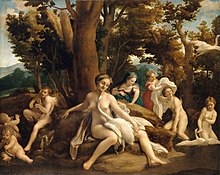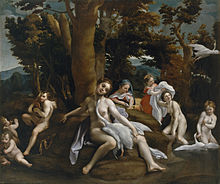Leda with the swan (Correggio)
The painting on the theme of Leda with the swan by Antonio Allegri, also called Il Correggio , was created between 1530 and the painter's death in 1534 as a commission for the Duke of Mantua, Federico II Gonzaga , for Correggio a cycle with motifs from Made love affairs of Zeus .
The painting is not well preserved as it was cut into three parts around 1721 and Leda's head was also torn out and destroyed. The current condition is based on several restorations and repainting of the middle part of the picture.
Material and technology
The 156.2 × 195.3 cm painting is painted with oil on canvas.
Image description
A bathing scene in a river landscape is shown. Leda is sitting under a tree on stones in the lower center of the picture . She is shown as a naked young girl. Her robe lies on the stone below her. Her legs are slightly to her left, her upper body is turned to the right and her right arm is propped back on a stone. Her gaze is directed downwards along her left arm. She has a calm expression with a slight smile. Your legs are a little open. A swan is pushing between her legs. Its wings are spread and its neck winds between Leda's breasts to her face. His beak seems to be touching her chin. Leda has put her left arm around the swan's wing as if she were pulling it towards her. The tree in the background divides the rest of the event into two halves.
On the right there are four young women. The first to Leda's right is wearing a white petticoat, over it a red dress and a blue coat. She leans on the stone in front of her and looks at the other women. A woman in a red dress helps the other either to get dressed or to undress. It is not possible to tell whether the girl is stepping into the river or out of the water. She stands knee-deep in the water. She is naked and looks up at a flying swan that has been cut off from the scene. Another undressed girl is in the water with a swan, towards which she shows a playful but defensive attitude.
On the left half of the picture male beings are shown. Two putti , one of them with wings, play wind instruments on the riverbank. One putti is draped towards the viewer, the other turns back towards the higher seated Cupid . He is naked and shown as a young man. He is sitting on the rock with one leg drawn up and shoulders hunched, playing a lyre . Next to him is a box with arrows. None of the characters, neither to the right nor to the left of the main event, seem to be impressed by Leda's interaction with the swan.
iconography
The subject of Leda with the swan comes from ancient mythology and was received in a series with other love adventures of Zeus in the 16th century. According to the stories, Leda was the daughter of King Thespius and married to Tyndareus , King of Sparta . Because of her beauty, Zeus noticed her and wanted to seduce her. To do this, he transformed himself into the shape of a swan so as not to get caught in his wife Hera with his affairs. In the shape of the swan, he pretended to seek refuge at Leda while fleeing from an eagle. When Leda offered him protection under her coat, he took advantage of the opportunity and impregnated her. Leda gave birth to two eggs. The story varies at this point: in some stories it is only Helena who is born from one egg, in others the twin pair Castor and Polydeukes are born from the other . According to other accounts, a total of four children are born from two eggs, with an additional Clytaimnestra . Leda was not the only one who accidentally approached Zeus: With Europa he turned into a bull, with Danae in a laburnum and with Io into a cloud.
There are many depictions of Leda in ancient art that are closer to the narrative than Correggio does. A statue in Rome shows Leda lifting her cloak for the swan and avoiding his gaze. This representation corresponds to Greek mythology . Over time, however, the representation with the naked Leda prevailed. A relief from the British Museum shows a violent depiction of events and a defensive attitude by Leda. Another type is the seated or lying Leda with the swan between her legs.
In the Renaissance , when ancient mythologies again played a stronger role, this motif also became more popular again. Before Correggio, Leonardo da Vinci and Michelangelo Buonarroti also painted Leda with the swan . While da Vinci's Leda interacts little with the swan, with the swan standing by her side more like an attribute, Michelangelo's Leda, lying down, with the swan between her legs, occupies the entire pictorial space. Michelangelo's painting has not survived, but can be traced in the engraving by Cornelius Bos. Correggio combines several of the earlier modes of representation with his picture: Leda is united with the swan, shown seated and at the same time frontal.
Correggio's way of portraying Leda differs from the others through the additional figures. The two putti can recall the twins Castor and Pollux, who appear in other depictions of Leda, including in the engraving by Bos. The women on the right side of the picture can be interpreted as Leda's entourage or as her companions. However, they can also be interpreted as simultaneous representations of other scenes of what is happening in the foreground, as they depict the process of undressing for the bathroom or of putting on afterwards. The game with the swan can also be found here and the swan flying away can be interpreted as an indication of the outcome of the event.
The complete nudity of Leda is explained in this picture by the bathing scene, so that the impression does not arise that Leda was waiting for the swan. Nevertheless, Correggio, following on from the imagery of his time, turns the actually brutal story through its idyllic landscape and Leda's posing posture into a supposedly amicable and cheerful scene.
Provenance
In addition to the Berlin Leda, three other pictures from Zeus' love cycle have been preserved: the painting of Danae in Rome and the robbery of Ganymede and Io in Vienna . Egon Verheyens suspects that the pictures were intended for a room in the summer residence of Isabella Boschetti, the official mistress of the Duke of Mantua. Correggio also painted the upbringing of Cupid and Satyr, Venus and Cupid for the Duke . Federico gave the paintings with Leda and Danae to Emperor Charles V, who took them to Spain . Correggios Leda was sold to Emperor Rudolph II in Prague in 1603 . In 1648 it came to Sweden as a war trophy . The Swedish Queen Christina brought the painting to Rome, where the owners changed several times. The painting came into the possession of the regent of France, Philippe von Oléans , in 1721 , whose son deliberately destroyed the painting. The painter Coypel then received it for restoration. In 1755 Frederick the Great bought the painting for his gallery in Sanssouci . When it was transferred to the Museum am Lustgarten in 1830, Jakob Schlesinger painted over Leda's head.
Status
When the painting came into the possession of the regent of France, Philippe von Orléans, in 1721, his son Louis tore the painting into three parts because he found the depiction of Leda offensive. He also cut out Leda's head and destroyed the piece that had been cut out. The painter Coypel received the individual parts as a gift and put the painting back together. He added the missing parts and changed Leda's head position, which was originally tilted lower. Also, her smile was probably much happier and her eyes open. This can be assumed based on a copy of the original illustration by Eugenio Caxes from 1603.
Comparison with “Danae” by Correggio
Correggio's painting of Danae is now in the Villa Borghese in Rome . Correggio painted this work and the Leda picture at the same time on behalf of Federico II Gonzaga . The pictures are about the same size and were therefore probably hung together. This picture shows how Zeus in the form of a golden rain gushes over the lap of Danae and thus begets Perseus. As in the Leda picture, Cupid appears here with the two putti. He looks at the golden cloud and holds a sheet that covers the otherwise uncovered Danae the spread thighs. In both pictures the women are depicted with a slight smile and, through the way they are depicted, adopt a balanced attitude in this union with Zeus.
literature
- Jana Schmalisch: Il Correggio: Leda with the swan; Gemäldegalerie, Staatliche Museen zu Berlin Preussischer Kulturbesitz, Berlin-Tiergarten, Kulturforum, Matthäikirchplatz. Gebr. Mann, Berlin 2001.
- Thomas Röske: Correggios Leda, a repressed image. In: Wessel Reinink, Jeroen Stumpel (ed.): Memory & oblivion: proceedings of the XXIXth International Congress of the History of Art held in Amsterdam, September 1 - 7, 1996. Dordrecht 1999.
- Cathleen S. Hoeniger: The Reception of Correggio's Loves of Jupiter. In: Lars Jones, Louisa Mettew (Ed.): Coming About: a Festschrift for John Shearman. Cambridge MA 2001.
- Rossana Mugellesi, Stefania Landucci: La donna, il cigno e il sogno. il mito di Leda da Correggio a Fellini. In: Art e dossier. 29.2014, 306, pp. 56-63.
Web links
- Leda with the swan, Il Correggio online database Staatliche Museen zu Berlin
- Fondazione Il Correggio, Leda
Individual evidence
- ↑ a b Jana Schmalisch: Il Correggio: Leda with the swan; Gemäldegalerie, Staatliche Museen zu Berlin Preussischer Kulturbesitz, Berlin-Tiergarten, Kulturforum, Matthäikirchplatz . Gebr. Mann, Berlin 2001, ISBN 3-7861-2385-3 , p. 7 .
- ↑ Guus Houtzager: Illustrated Greek Mythology Encyclopedia . Dörfler, Eggolsheim 2006, ISBN 978-3-89555-400-1 , p. 156 .
- ↑ a b Jana Schmalisch: Il Correggio: Leda with the swan; Gemäldegalerie, Staatliche Museen zu Berlin Preussischer Kulturbesitz, Berlin-Tiergarten, Kulturforum, Matthäikirchplatz . Gebr. Mann, Berlin 2001, ISBN 3-7861-2385-3 , p. 8 .
- ↑ Leda with the swan - Antonio Allegri da Correggio. Retrieved June 24, 2020 .
- ↑ Jana Schmalisch: Il Correggio: Leda with the swan; Gemäldegalerie, Staatliche Museen zu Berlin Preussischer Kulturbesitz, Berlin-Tiergarten, Kulturforum, Matthäikirchplatz . Gebr. Mann, Berlin 2001, ISBN 3-7861-2385-3 , p. 12 .
- ↑ Jana Schmalisch: Il Correggio: Leda with the swan; Gemäldegalerie, Staatliche Museen zu Berlin Preussischer Kulturbesitz, Berlin-Tiergarten, Kulturforum, Matthäikirchplatz . Gebr. Mann, Berlin 2001, ISBN 3-7861-2385-3 , p. 27 .
- ↑ a b Jana Schmalisch: Il Correggio: Leda with the swan; Gemäldegalerie, Staatliche Museen zu Berlin Preussischer Kulturbesitz, Berlin-Tiergarten, Kulturforum, Matthäikirchplatz . Gebr. Mann, Berlin 2001, ISBN 3-7861-2385-3 , p. 28, 29 .
- ↑ Michael Eissenhauer: Favorite pieces of the general director: Leda with the swan. Accessed June 24, 2020 (German).
- ↑ Jana Schmalisch: Il Correggio: Leda with the swan; Gemäldegalerie, Staatliche Museen zu Berlin Preussischer Kulturbesitz, Berlin-Tiergarten, Kulturforum, Matthäikirchplatz . Gebr. Mann, Berlin 2001, ISBN 3-7861-2385-3 , p. 29 .
- ↑ Jana Schmalisch: Il Correggio: Leda with the swan; Gemäldegalerie, Staatliche Museen zu Berlin Preussischer Kulturbesitz, Berlin-Tiergarten, Kulturforum, Matthäikirchplatz . Gebr. Mann, Berlin 2001, ISBN 3-7861-2385-3 , p. 16 .





